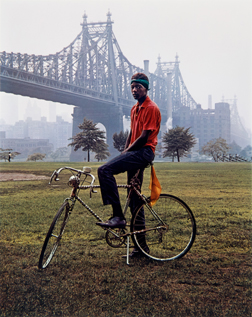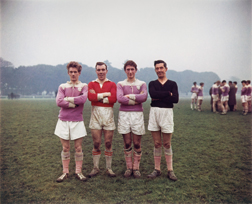Exhibition information
Photographs since 1955
March 31st - June 27th 2001
Evelyn Hofer, born in Germany in 1922, has been working as a photographer since the mid-1940s. Her work is inextricably bound up with the books she illustrated in the late 1950s and 1960s for acclaimed authors such as Mary McCarthy and V.S. Pritchett, unforgettably evoking the atmosphere of places like Dublin, London and New York. Her photographs are also well-known from magazines such as Life, the London Times Magazine and the New York Times Magazine. And yet, in the beginning of 21rst century, she is still “the most famous 'unknown' photographer in America.”
Evelyn Hofer's photographic work covers a wide spectrum of subjects and genres. She has distinguished herself as a photographer of architecture, interiors, landscapes, but also for her sensitive still lifes and portraits. She is uncompromising in her commitment to honesty and directness in her pictures, exhibiting a deep empathy and understanding that allows her to bring out the innate beauty in her subjects. She seems to have an intuitive talent for getting to the core of each object or person she photographs. One senses that she takes plenty of time to get to know her subject before taking up her camera. She needs time to arrive at where she wants to be, to become part of what she is trying to capture or to generate a certain closeness to her subject. This means for her-and through her photographs for us as well-to apprehend the underlying nature of her subject. Until she has discovered just what that is, she is not ready to take the picture. Creating a personal connection is her basic requirement for any photograph. Recording the essential, the unchanging is her goal.
Evelyn Hofer has never been one to follow the latest artistic trends. Her work is more classic than avant-garde, although her pictures are undoubtedly characteristic witnesses of their times. She has a finely tuned eye for proportion, form, color and light. Her compositions are subtle and well thought-out. And since she has a brilliant grasp of the technical side of the medium, she has no need for special effects. For her, the technology is merely the means to an end-to achieving just the picture she wants.
Her work is not suffused with the explanatory, investigative drive of documentary photography. She is not out to astound or surprise her viewers. This is all the more remarkable when one notes the unconditional accuracy of her perception and her attention to the most minute details. But a portrait by Evelyn Hofer, for example, never has the effect of unmasking or laying bare her sitter. Even as she subjects the sitter to her unstinting gaze and renders details with painstaking clarity, her appraisal is tempered with a warmhearted sympathy that one can sense in the final photograph. She was the one who once advised photographers to choose an extremely long exposure time for portraits-because that way much more of the subject's personality comes through in the picture.
Evelyn Hofer, born in Germany in 1922, has been working as a photographer since the mid-1940s. Her work is inextricably bound up with the books she illustrated in the late 1950s and 1960s for acclaimed authors such as Mary McCarthy and V.S. Pritchett, unforgettably evoking the atmosphere of places like Dublin, London and New York. Her photographs are also well-known from magazines such as Life, the London Times Magazine and the New York Times Magazine. And yet, in the beginning of 21rst century, she is still “the most famous 'unknown' photographer in America.”
Evelyn Hofer's photographic work covers a wide spectrum of subjects and genres. She has distinguished herself as a photographer of architecture, interiors, landscapes, but also for her sensitive still lifes and portraits. She is uncompromising in her commitment to honesty and directness in her pictures, exhibiting a deep empathy and understanding that allows her to bring out the innate beauty in her subjects. She seems to have an intuitive talent for getting to the core of each object or person she photographs. One senses that she takes plenty of time to get to know her subject before taking up her camera. She needs time to arrive at where she wants to be, to become part of what she is trying to capture or to generate a certain closeness to her subject. This means for her-and through her photographs for us as well-to apprehend the underlying nature of her subject. Until she has discovered just what that is, she is not ready to take the picture. Creating a personal connection is her basic requirement for any photograph. Recording the essential, the unchanging is her goal.
Evelyn Hofer has never been one to follow the latest artistic trends. Her work is more classic than avant-garde, although her pictures are undoubtedly characteristic witnesses of their times. She has a finely tuned eye for proportion, form, color and light. Her compositions are subtle and well thought-out. And since she has a brilliant grasp of the technical side of the medium, she has no need for special effects. For her, the technology is merely the means to an end-to achieving just the picture she wants.
Her work is not suffused with the explanatory, investigative drive of documentary photography. She is not out to astound or surprise her viewers. This is all the more remarkable when one notes the unconditional accuracy of her perception and her attention to the most minute details. But a portrait by Evelyn Hofer, for example, never has the effect of unmasking or laying bare her sitter. Even as she subjects the sitter to her unstinting gaze and renders details with painstaking clarity, her appraisal is tempered with a warmhearted sympathy that one can sense in the final photograph. She was the one who once advised photographers to choose an extremely long exposure time for portraits-because that way much more of the subject's personality comes through in the picture.

Queensboro Bridge, New York, 1964
Dye Transfer 51,5 x 40,5 cm (42,5 x 33,6 cm)
Dye Transfer 51,5 x 40,5 cm (42,5 x 33,6 cm)

Phoenix Park on a Sunday, Dublin, 1966
Dye Transfer 34 x 41,5 cm (40,5 x 50,5 cm)
Dye Transfer 34 x 41,5 cm (40,5 x 50,5 cm)
